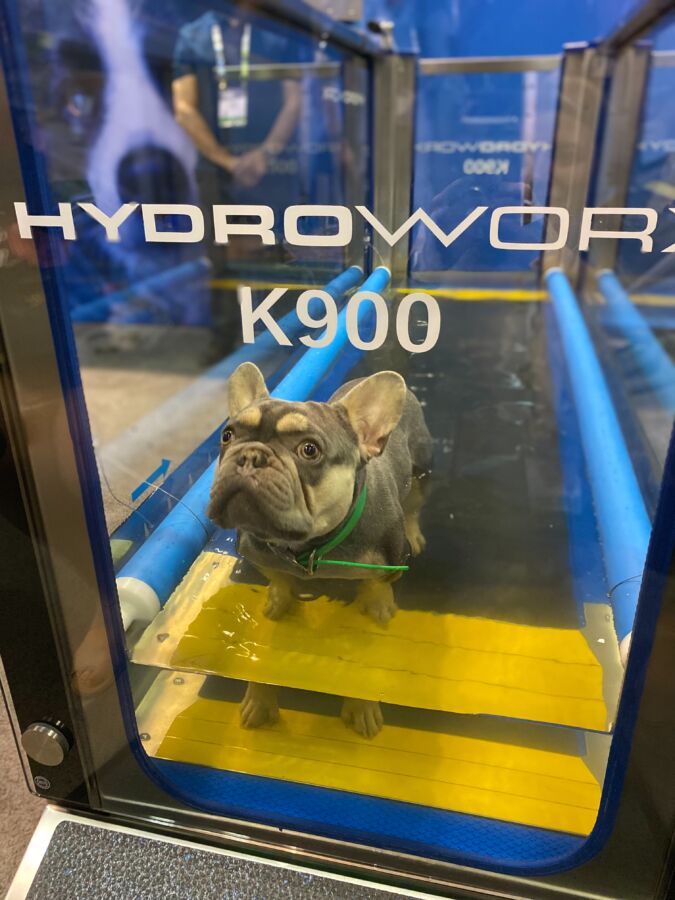5 Tools For Veterinary Underwater Treadmills
A muti-modal approach to rehabilitation
The key to successful physical rehabilitation is a mutli-modal approach to care. In this blog we’ll review 5 tools that pair well with canine hydrotherapy.
What Is Veterinary Hydrotherapy
Hydrotherapy, specifically underwater treadmills, are used widely among rehab veterinarians to provide a safe environment for post-surgical and injury recovery.
Underwater treadmills, like the HydroWorx K900, utilize warm water therapy to enhance rehabilitation. Veterinarians determine the height of the water, ramp incline, and treadmill speed based on the patient’s rehabilitation goals. Hydrotherapy enables sore pets to ease into movement in a safe and comfortable environment.

Canine Underwater Treadmill Accessories
Common veterinary underwater treadmill accessories include:
- Pool noodles to act as “guard rails” to keep pets away from the sides of the unit.
- Life vests keep pets safe while they walk on the underwater treadmill.
- Harnesses to allow easy access to help larger dogs while they are inside the unit.
- Slings can also be used to help stabilize hindquarters during therapy.
- Toys encourage pets to participate in therapy and make hydrotherapy sessions fun.
- Harness frames allow for additional support during therapy.

5 Key Tools For Canine Hydrotherapy
If you’ve got a hydrotherapy program or are considering adding one, here are 5 tools to consider adding to your rehabilitation toolbox that work hand-in-hand with hydrotherapy.
#1 Exercise Equipment
Exercise programs are almost always paired with hydrotherapy. Manual exercise can be performed either before or after hydrotherapy depending on the pet and condition. A warm soothing session in the underwater treadmill loosens up sore muscles and can prepare tissue for more successful manual therapy. Here are a few common pieces of exercise equipment that pair well with hydrotherapy:
- Resistance Bands: These bands are used for strength training exercises and are available in variable elasticities.
- Cavaletti Rails: These adjustable hurdles are commonly used for gait retraining, range of motion exercises, and to refine coordination and balance.
- Stability Balls: Balance discs or stability balls can be used for core strengthening or in combination with exercises to improve balance, coordination, and muscle strength.
#2 Laser Therapy
Laser therapy is a versatile treatment modality and pairs well both before and after hydrotherapy (after the patient is dry). If a patient is very stiff and sore laser therapy, also known as photobiomodulation (PBM), can be applied before hydrotherapy to reduce pain and increase range of motion.
Laser therapy quickly reduces pain and inflammation and can be used on almost every part of the body. The therapy is pain-less and non-invasive. Clinicians simply scan the patient’s body with a handpiece that delivers light energy for a fast and soothing treatment.
Pets quickly relax and sometimes even fall asleep during laser treatments. If your patient is feeling anxious about their hydrotherapy session consider starting with a laser treatment to give them quick pain relief and sooth them before getting on the underwater treadmill.
#3 Therapeutic Massage
Massage therapy relaxes muscles, improves circulation, and reduces pain. The best part–no equipment is required! Massage therapy can also reduce stress. Often massage therapy is used after hydrotherapy when the pet’s muscles are loosened up from the warm water hydrotherapy session.
Finishing a rehabilitation session with massage therapy improves circulation, relieves pain, and can ease aches in compensatory pain sites.
Veterinarians often combine manual massage with the following veterinary massage tools:
- Foam rollers
- Massage balls
- Rubber curry combs
- Myofascial release tools
- Percussion massagers
- Vibrating massage tools
Percussion and vibrating massage tools often require several sessions to get the pet comfortable with the sensation.
#4 Therapeutic Ultrasound
Unlike diagnostic ultrasound, therapeutic ultrasound uses waves to produce deep heat. Therapeutic ultrasound is used to promote healing, and reduce pain and inflammation. The indications of therapeutic ultrasound are very similar to laser therapy. Typically a hydrotherapy session will either include therapeutic ultrasound treatment or laser therapy.
Therapeutic ultrasound requires clipping of the fur coat to apply the treatment on the surface of the skin with a transducer. Sometimes laser therapy is preferred because of its ability to be administered through a fur coat and by a veterinary technician.
Because of its ability to produce deep tissue heat, therapeutic ultrasound should only be administered by a trained veterinary professional.
#5 E-Stim
E-stim can be utilized in combination with hydrotherapy to relieve pain and strengthen muscles. There are two common types of e-stim used in veterinary rehabilitation:
- Transcutaneous Electric Nerve Stimulation (TENS)
Primarily used for pain relief, TENS delivers low-voltage electric impulses through electrodes to block pain signals from reaching the brain. - Neuromuscular Electrical Stimulation (NMES)
NMES stimulates muscle contractions and is used to help strengthen weak muscles. NMES also stimulates blood flow to the area and is commonly used for neurological and musculoskeletal rehabilitation.
E-stim can be used both before or after hydrotherapy sessions based on patient goals. Sometimes e-stim is used before hydrotherapy to relieve pain, others e-stim is used after hydrotherapy sessions have loosened muscles, making e-stim more effective.
Getting Started with Hydrotherapy
Contact us to discuss getting started with veterinary hydrotherapy.

